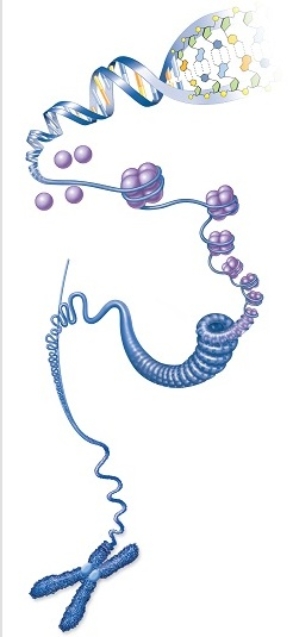A) cell plate.
B) nuclear envelope.
C) cell wall.
D) nucleolus.
E) cleavage furrow.
Correct Answer

verified
Correct Answer
verified
Multiple Choice
Strong evidence of semiconservative replication of DNA comes from the DNA molecule structure,in that
A) the DNA molecule has four distinct nitrogen base pairs, requiring minimal chemical bond reactions to replicate their sequence.
B) All these properties of DNA and the replication process are part of the evidence and definition of semiconservative replication.
C) the semiconservative replication is explained by the large number of enzymes that are each specialized for each step of replication.
D) the DNA molecule is double-stranded, allowing one original strand to be conserved while its replicate forms one strand.
E) the hydrogen bonds between paired DNA strands allows conservation of energy, at a lower level than covalent bonds would require.
Correct Answer

verified
Correct Answer
verified
Multiple Choice
The four nitrogen bases that are found in the different nucleotides of DNA are
A) adenine, thymine, cytosine, guanine.
B) uracil, adenine, cytosine, guanine.
C) None of the answer choices are correct.
D) adenine, thymine, cytosine, uracil.
E) uracil, cytosine, guanine, thymine.
Correct Answer

verified
Correct Answer
verified
Multiple Choice
In order for a cell to become cancerous,oncogenes must be ___,or tumor suppressors are ___.
A) activated; activated
B) activated; inactivated
C) inactivated; inactivated
D) inactivated; activated
Correct Answer

verified
Correct Answer
verified
Multiple Choice
A person,who has just experienced a painful sunburn,has a large number of cells undergoing mitosis for the purpose of
A) replication of new DNA copies, so that meiosis will further grow new skin cells.
B) modifying new cells that will have different specialties than the original damaged cells.
C) asexual reproduction, to produce new skin buds that will fold over and cover the burn.
D) repairing and replacing the damaged cells, in the healing process of the skin.
Correct Answer

verified
Correct Answer
verified
Multiple Choice
Endostatin is a 184-amino acid protein that only affects endothelial cells.What is the best explanation for this observation?
A) Endostatin enters endothelial cells by endocytosis.
B) Endostatin can diffuse across the membrane of endothelial cells.
C) Endothelial cells have a receptor on their cell membrane that binds endostatin.
D) Only endothelial cells are exposed to endostatin.
E) Endothelial cells produce endostatin.
Correct Answer

verified
Correct Answer
verified
Multiple Choice
Figuer:
This diagram shows how DNA is packaged and folded with its associated protective and regulatory proteins.  -A discrete continuous molecule of DNA,wrapped with its associated proteins,defines the term
-A discrete continuous molecule of DNA,wrapped with its associated proteins,defines the term
A) histone.
B) genome.
C) nucleosome.
D) centromere.
E) chromosome.
Correct Answer

verified
Correct Answer
verified
Multiple Choice
Mutations are usually rare,because
A) Okazaki fragments are removed, whenever detected by the ligase enzyme.
B) transcription, after replication, will normally detect and fix mutations.
C) ligases serve to conduct "quality control" checks in order to repair mutations.
D) DNA polymerase quickly discards mismatched nucleotide base pairs.
E) Both answer options, regarding the role of the ligase enzyme, are correct.
Correct Answer

verified
Correct Answer
verified
Multiple Choice
The chemotherapy drug taxol inhibits the breakdown of microtubules.A cell treated with taxol would become stuck right after which phase?
A) metaphase
B) telophase
C) anaphase
D) cytokinesis
E) prophase
Correct Answer

verified
Correct Answer
verified
Multiple Choice
The process by which DNA is reproduced,with the use of associated enzymes,is
A) translation.
B) catalyzed protein synthesis.
C) transcription.
D) ligation.
E) replication.
Correct Answer

verified
Correct Answer
verified
True/False
Each newly replicated molecule of DNA contains one conserved strand from the original DNA molecule.
Correct Answer

verified
Correct Answer
verified
Multiple Choice
The portion of the cytoskeleton that attaches,pulls,and guides the chromosomes as they are separated equally into two sets is the
A) centrosome.
B) Golgi body.
C) centromere.
D) mitotic spindle.
E) kinetochore.
Correct Answer

verified
Correct Answer
verified
Multiple Choice
If one strand of a DNA molecule has the base sequence of 5'-ATGTGCC-3' the complementary strand of DNA will read
A) 3'-UACACGG-5'
B) 3'-GGCACAT-5'
C) 3'-CGTGTAA-5'
D) 3'-ATGTGCC-5'
E) 3'-TACACGG-5'
Correct Answer

verified
Correct Answer
verified
True/False
An abnormal mass of tissue is a tumor.
Correct Answer

verified
Correct Answer
verified
Multiple Choice
Figuer:
This diagram shows the steps in mitosis, with labels to reference in the questions below.  -The phase of mitosis in which the nuclear envelope reforms is
-The phase of mitosis in which the nuclear envelope reforms is
A) E, which is telophase.
B) C, which is anaphase.
C) A, which is prometaphase.
D) D, which is metaphase.
E) B, which is prophase.
Correct Answer

verified
Correct Answer
verified
Multiple Choice
When DNA replicates
A) transcription factors determine where to begin DNA replication.
B) the original DNA unwinds, and multiple copies of a region are transcribed before the DNA closes back up.
C) the original DNA is not affected and a new double-stranded DNA is made from two new strands of DNA.
D) None of the answer choices are correct.
E) one strand of the original DNA ends up in each of the new DNA molecules.
Correct Answer

verified
Correct Answer
verified
True/False
During the cell cycle there are several checkpoints that ensure that the cell cycle is proceeding correctly.
Correct Answer

verified
Correct Answer
verified
Multiple Choice
If scientists could inactivate telomerase in specific cells,the primary reason for this would most likely be the stopping of
A) the formation of cancer.
B) meiosis.
C) aging of cells.
D) All of the answer choices are correct.
E) aerobic respiration.
Correct Answer

verified
Correct Answer
verified
Multiple Choice
The enzyme that builds a short complementary piece of RNA at the start of each DNA segment to be replicated is
A) helicase.
B) ligase.
C) DNA polymerase.
D) primase.
E) ATP synthase.
Correct Answer

verified
Correct Answer
verified
True/False
Cells that produce telomerase can usually divide many more times than cells that do not produce telomerase.
Correct Answer

verified
Correct Answer
verified
Showing 21 - 40 of 83
Related Exams